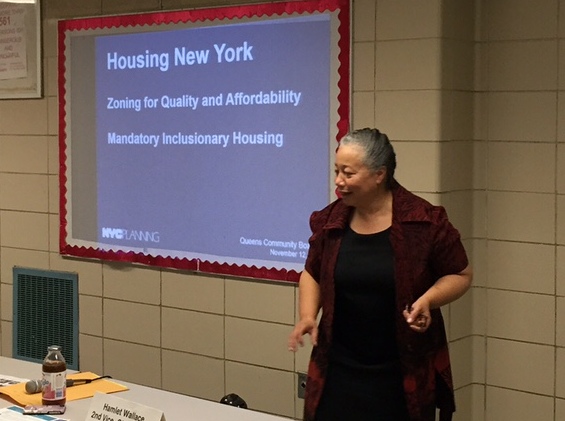
Deborah Carney from City Planning
Nov. 13, 2015 By Christian Murray
The City’s push to amend the zoning code as a means to promote the construction of affordable housing was approved by Community Board 3 last night in what proved to be a tight vote.
Several board members took issue with several elements in the proposed amendments, such as the elimination of the parking space requirement for affordable and senior housing units near subway stations.
Others were wary that developers could build their required affordable units on a different site than their market rate building.
Hamlett Wallace, the chair of the Land Use Committee who recommended approving the amendments, warned members that there is no such thing as a perfect zoning plan.
“There is no perfect scenario, there never is,” Wallace said. “But if you vote against it we would have nothing. And when it is all said and done, we want places where seniors [and low-to-middle income residents] can live.”

Hamlett Wallace
The board voted on two amendments and both were approved by a vote of 16 for and 11 against. Unlike some other boards, the approvals were with condition.
One amendment, called Zoning for Quality and Affordability, largely deals with increased building heights and the elimination of the parking spaces currently required for affordable units and affordable senior units located within a half mile of mass transit/subways.
Within a large swath of Jackson Heights, the ZQA amendment would allow buildings to stretch five feet higher than current regulations allow. The extra five feet would largely be applied to the ground floor space, which would essentially lead to bigger residential lobby areas or larger ground floor retail space.
The height increase, according to the Dept. of City Planning, is intended to give builders more flexibility within existing zoning rules, to encourage new housing construction with more engaging architecture.
Similar tweaks to zoning rules, permitted by the ZQA, would incentivize affordable senior housing in the neighborhood.
Developers who build affordable senior homes or long term care facilities could build 10 or 20 feet higher than currently allowed, depending on zoning district. In a wider chunk of the district, developers of certain types of senior housing and long term care facilities would also be allowed to build slightly bigger buildings.
The Board did not take issue with these height and density changes.
The elimination of parking requirements at affordable and senior housing—which would apply throughout much of neighborhood—generated the greatest concern.
DCP argues that in areas such as Jackson Heights, where public transportation is available, low-income and senior households own fewer cars and the off-street parking provided to them often goes to waste.
By removing the requirement, DCP said, it would remove an unnecessary cost to affordable housing developers.
“People need parking,” said Arthur Teiler, a board member, who took exception to the elimination of the parking requirement. He said he is in his 80s and still uses his car. He added that it was tough for residents to find a space in the neighborhood.
“I think that is a deal breaker and I will vote against it,” he said.
Deborah Carney, with the Department of City Planning, said that developers would still able be able to put in as much parking as they would like. However, it just wouldn’t be a requirement.
DCP’s other zoning text amendment, called Mandatory Inclusionary Housing, would require that new developments of more than 10 units include 25 or 30 percent permanently affordable housing when a rezoning to increase housing capacity occurs.
Therefore, if a private developer built a residential tower in Jackson Heights, and asked the City for a rezoning of the property to permit construction of more units, MIH would be triggered.
Developers would not be required to put the affordable apartments in the same building as the market-rate apartments. Instead, they could build them in a separate building in another part of the community board district or within half a mile from market-rate development.
Ann Brown, a board member, took exception to this portion of the text. She said it wasn’t right that developers would be able to build affordable apartments in a different location from the market rate units. She opposed the amendment.
Representatives of CB3 will be attending a meeting with Queens Borough President Melinda Katz on Monday, where the heads of all Queens community boards will take a vote on the amendments.
In western Queens, Community Board 2 opposed the amendments last week, while Community Board 1 approved them subject to several conditions on Tuesday.
CB3 and zoning text amendment by Queens Post
.
Mih Presentation 0915 by Queens Post






